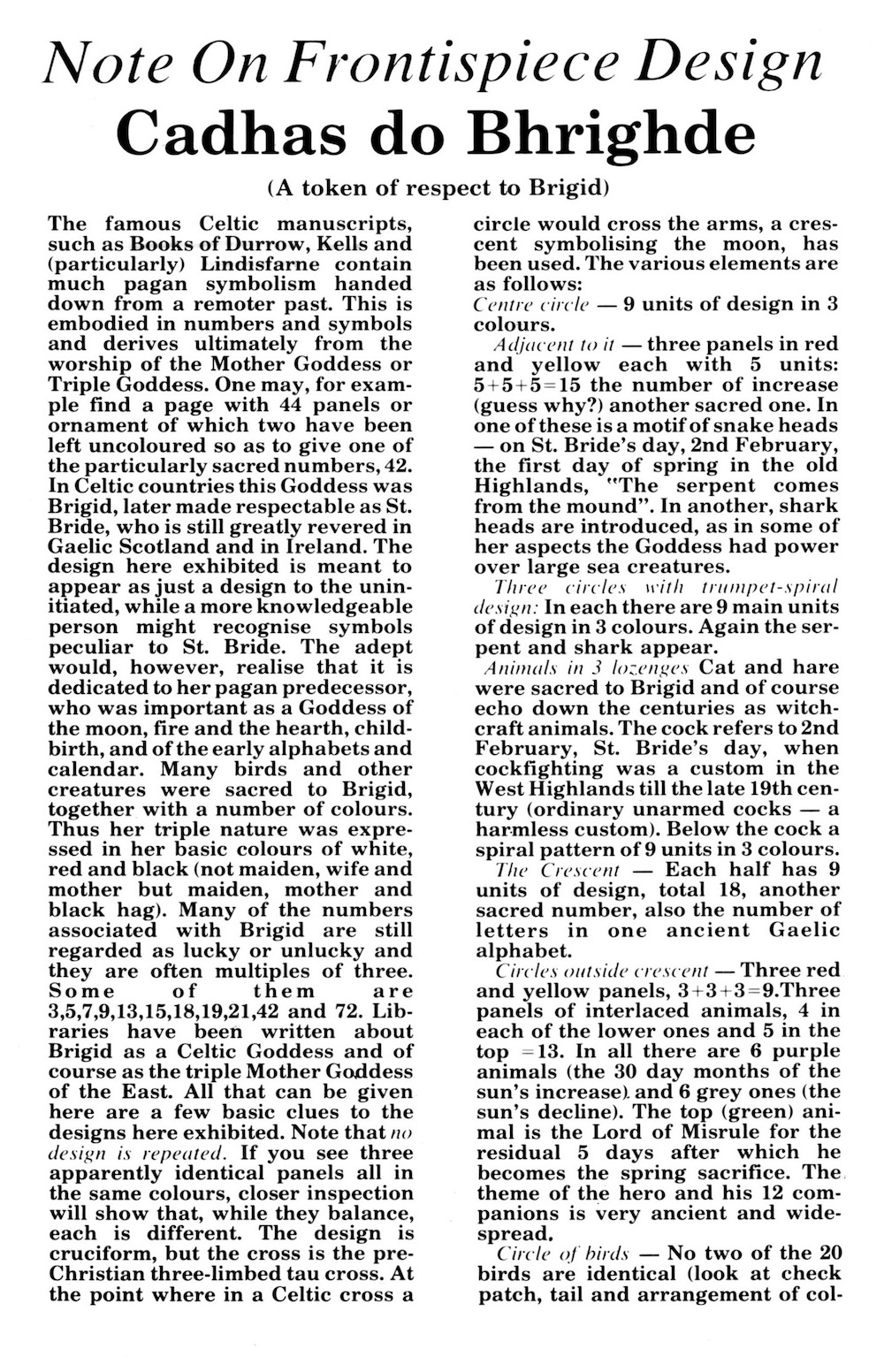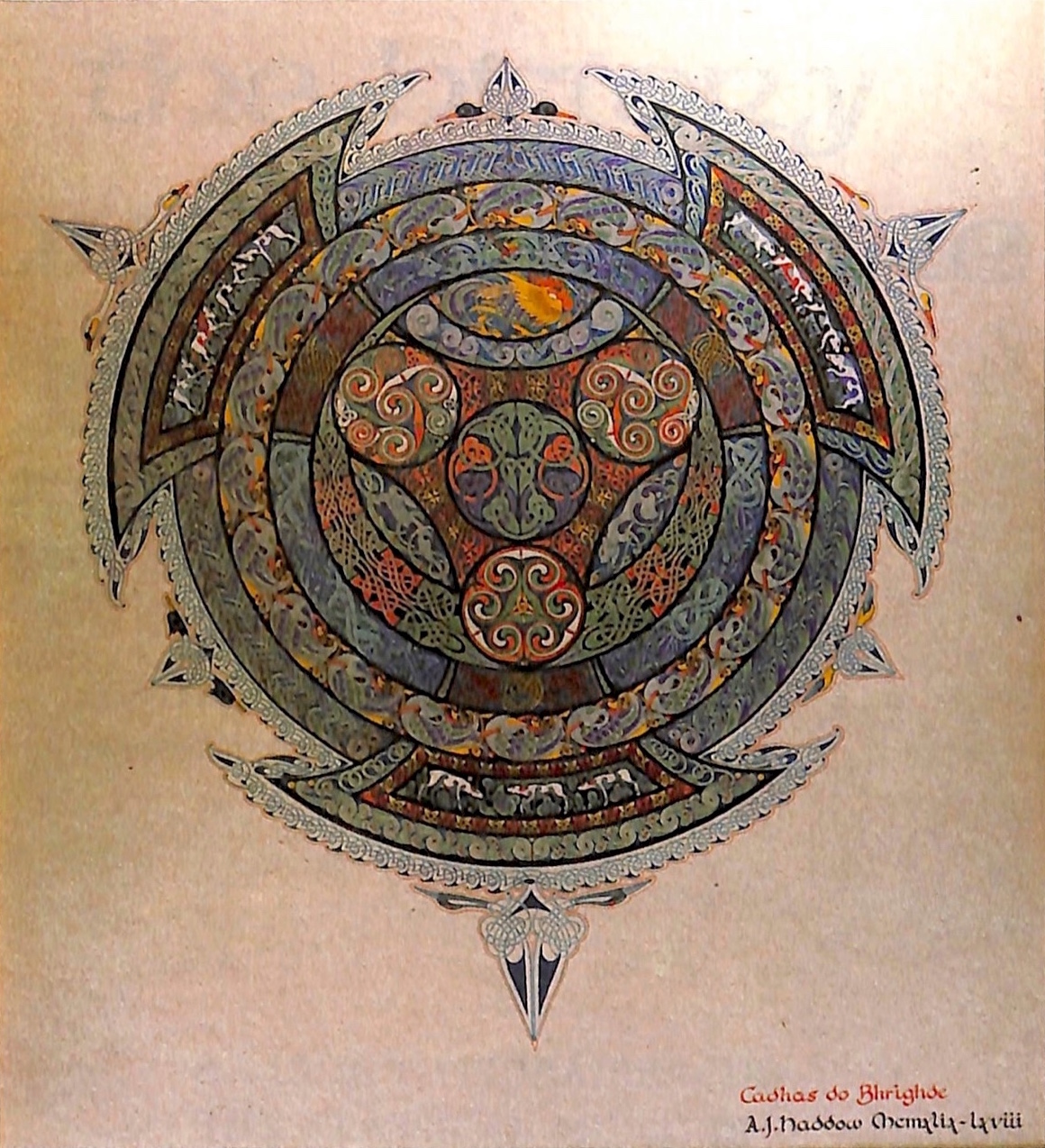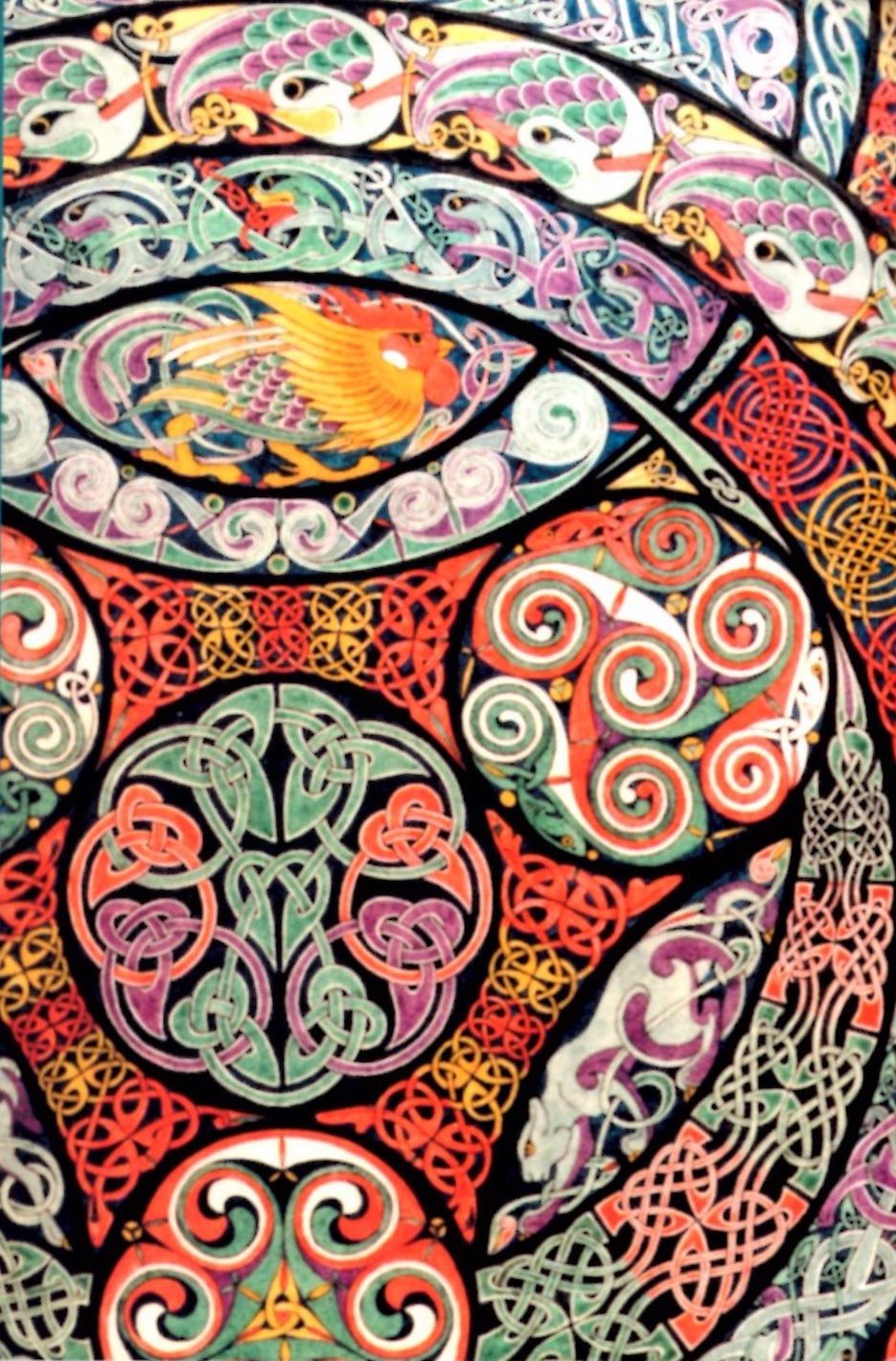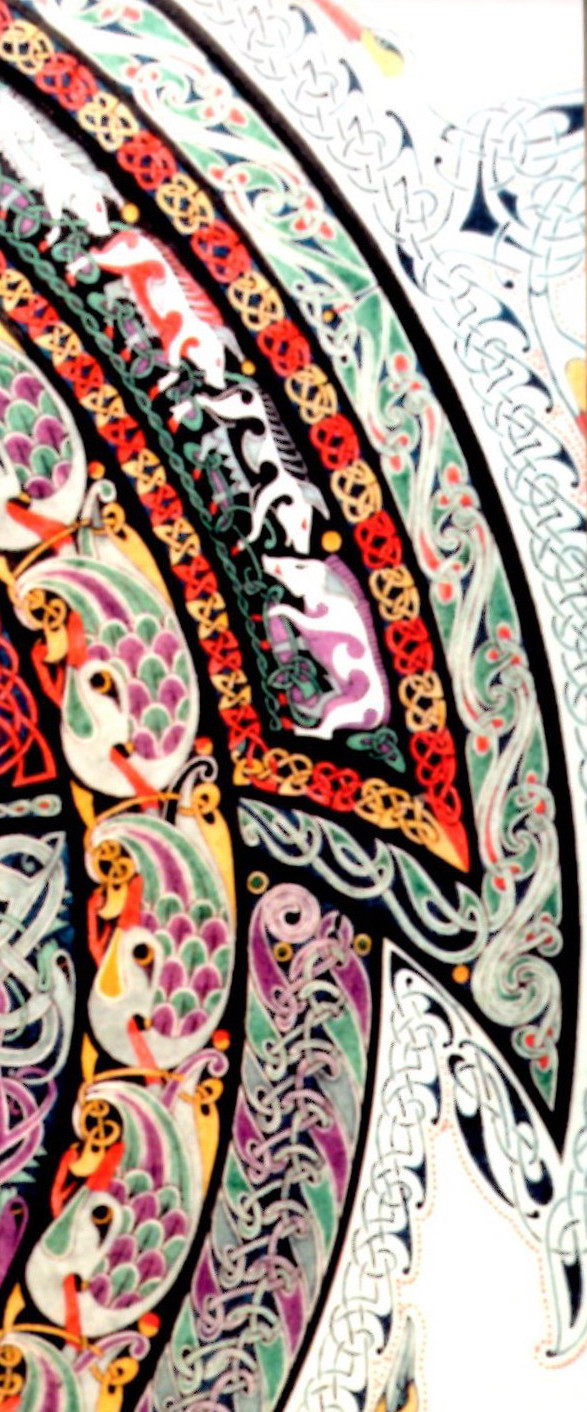第49話(2022/12)
Cadhas
do Bhrighde(A token of respect to Brigid)
Note On Frontispiece Design of
"The History and Structure of Ceol Mor"
by Professor Alex J. Haddow
パイプのかおり第48話に引き続き Professor Alex J. Haddow モノ第2弾です。
Canntaireachd No.11 でも触れましたが、"The History and Structure of Ceol Mor" の扉ページに口絵として挿入されているケルト装飾模様は、Haddow 自身が19年もの歳月を掛けて描き上げたという傑 作。見事な芸術作品です。
 口絵に続いて、その次の2ページに渡ってビッシリとその図柄に関する解
説が書かれています。このバイブルを手にした時に一度目を通した事があるのですが、余りにも細かい文字で最小限の改行や
見出し抜きで書かれている上に、神話などに関する専門的な用語や言い回しに目が眩んで、その内容が少しも頭に入って来ま
せんでした。
口絵に続いて、その次の2ページに渡ってビッシリとその図柄に関する解
説が書かれています。このバイブルを手にした時に一度目を通した事があるのですが、余りにも細かい文字で最小限の改行や
見出し抜きで書かれている上に、神話などに関する専門的な用語や言い回しに目が眩んで、その内容が少しも頭に入って来ま
せんでした。第48話を書くに当たって、この本の Editor's Note と Foreword を翻訳ソフトに掛けて改めて読み直した際、ついでにこの説明文も翻訳ソフトに掛けてみました。しかし、スキャンした文字があちこちで薄かったり、文章の区 切りが分かりにくいので、なかなか理解可能な日本語に翻訳できません。そこで、腰を落ち着けて、まずは英文テキストを ワープロソフトにコピペして、自分なりに見出しを明確にし、段落を区切り、適宜改行した上で翻訳ソフトに掛けて、漸くど うにかこうにか理解可能なレベルになりました。
Haddow は、このケルト模様を構成するそれぞれのセクションに登場する鳥や動物の名前や数だけでなく、それらが意味する所について、事細かに解説している事が判り ました。
このたった2ページの説明文だけでも、ケルト文化の独特な考え方がヒシヒシと伝わって来るの は確か。読めば読む程に興味深い内容だと感じ入るばかりでした。読み易くした原文と共に翻訳文を以下にベタに紹 介します。ぜひ、お楽しみ下さい。
画像については、当時は未だデジタルカメラや大型スキャナーなど無かった時代、この口絵はオリジナル作品をフィルムカ メ ラで写真撮影した物だと思われます。解像度も低く、更にそれなりのサイズであると思われるオリジナル作品を、本のサイズまで 縮小している様なので、細かな部分は極めて不鮮明。いくら、事細かに説明されても、その様な図柄を確認する事はなかなか 難しいものがあります。
ネットのどこかにオリジナルの鮮明な画像が無いものか?と検索を掛けますが、出て来るのは偉大な足跡を残した医学博 士 Alex J. Haddow の業績ばかりで、今の所、趣味の分野の資料には行き当たりませんでした。
その様な中で、パイプのかおり第28話で紹介した Allan MacDonald の "Dustrium" の CDジャケットにこの模様の一部が3カ所の分散して再現されている物がこれまでの所、唯一より鮮明な画像として参照できる物です。全体図と併せて参照して 下さい。(上3つはクリックで僅かに拡大します)




| 原 文 |
日本語訳 |
|---|---|
|
Cadhas do Bhrighde(A token
of respect to Brigid)
The famous Celtic manuscripts, such as Books of Durrow, Kells and (particularly) Lindisfarne contain much pagan symbolism handed down from a remoter past. This is embodied in numbers and symbols and derives ultimately from the worship of the Mother Goddess or Triple Goddess. One may, for example find a page with 44 panels or ornament of which two have been left uncoloured so as to give one of the particularly sacred numbers, 42. In Celtic countries this Goddess was Brigid, later made respectable as St. Bride, who is still greatly revered in Gaelic Scotland and in Ireland. The design here exhibited is meant to appear as just a design to the uninitiated, while a more knowledgeable person might recognise symbols peculiar to St. Bride. The adept would, however, realise that it is dedicated to her pagan predecessor, who was important as a Goddess of the moon, fire and the hearth, childbirth, and of the early alphabets and calendar. Many birds and other creatures were sacred to Brigid, together with a number of colours. Thus her triple nature was expressed in her basic colours of white, red and black (not maiden, wife and mother but maiden, mother and black hag). Many of the numbers associated with Brigid are still regarded as lucky or unlucky and they are often multiples of three. Some of them are 3, 5, 7, 9, 13, 15, 18, 19, 21, 42 and 72. Libraries have been written about Brigid as a Celtic Goddess and of course as the triple Mother Goddess of the East. All that can be given here are a few basic clues to the designs here exhibited. Note that no design is repeated. If you see three apparently identical panels all in the same colours, closer inspection will show that, while they balance, each is different. The design is cruciform, but the cross is the pre-Christian three-limbed tau cross. At the point where in a Celtic cross a circle would cross the arms, a crescent symbolising the moon, has been used. The various elements are as follows : |
ブリジットへの敬意の印
ダロウ書、ケルズ書、(特に) リンディスファーン書などの有名なケルト写本には、遠い過去から受け継がれた多くの異教の象徴が含まれています。 これは数字と記号で具現化され、最終的には母なる女神または三位一体の女神の崇拝に由来します。 たとえば、44 枚のパネルまたは装飾品を含むページを見つけることができますが、そのうちの2枚は、特に神聖な数字の1つである 42 を与えるために着色されていません。 ケルト諸国では、この女神はブリジッドであり、後に聖ブライドとして尊敬され、ゲール語のスコットラ ンドとアイルランドで今でも大いに尊敬されています。ここに展示されているデザインは、初心者には単な るデザインとして表示されることを意図していますが、より知識のある人は聖ブライド特有のシンボルを認 識できるかもしれません。 しかし、熟達者は、それが月、火、炉、出産、そして初期のアルファベットとカレンダーの女神として重 要だった彼女の異教徒の前任者に捧げられていることに気付くでしょう。多くの鳥やその他の生き物は、多 くの色とともに、ブリジッドにとって神聖なものでした。 したがって、彼女の三重の性質は、白、赤、黒の基本色(乙女、妻、母ではなく、乙女、母、黒魔女)で 表 現されました。 ブリジッドに関連付けられている数字の多くは、依然として幸運または不運と見なされており、多くの場 合、3 の倍数です。 それらのいくつかは、3、5、7、9、13、15、18、19、21、42、72 です。 図書館の本には、ブリジッドをケルトの女神として、そしてもちろん東方の3重の母の女神として書かれ てきました. ここで提供できるのは、ここに展示されているデザインの基本的な手がかりです。 デザインは繰り返されないことに注意してください。 3 つの一見すると同一のパネルがすべて同じ色で表示されている場合、詳しく調べてみると、それらのバランスは取れていますが、それぞれが異なっていることが わかります。 デザインは十字形ですが、十字架はキリスト教以前の 3 本足のタウ十字です。 ケルト十字で円が腕を横切るポイントで、月を象徴する三日月が使用されています。 それぞれの要素は次の通りです: |
| Centre circle 9 units of design in 3 colours. Adjacent to it three panels in red and yellow each with 5 units : 5+5+5=15 the number of increase (guess why?) another sacred one. In one of these is motif of snake heads ー on St. Bride's day, 2nd February, the first day of spring in the old Highlands, "The serpent comes from the mound". In another, shark heads are introduced, as in some of her aspects the Goddess had power over large sea creatures. Three circles with trumpet : spiral design In each there are 9 main units of design in 3 colours. Again the serpent and shark appear. Animals in 3 lozenges Cat and hare were sacred to Brigid and of course echo down the centuries as witchcraft animals. The cock refers to 2nd February, St. Bride's day, when cockfighting was a custom in the West Highlands till the late 19th century (ordinary unarmed cocks ー a harmless custom). Below the cock a spiral pattern of 9 units in 3 colours. The Crescent Each half has 9 units of design, total 18, another sacred number, also the number of letters in one ancient Gaelic alphabet. Circles outside crescent Three red and yellow panels, 3+3+3=9. Three panels of interlaced animals, 4 in each of the lower ones and 5 in the top =13. In all there are 6 purple animals (the 30 day months of the sun's increase), and 6 grey ones (the sun's decline). The top (green) animal is the Lord of Misrule for the residual 5 days after which he becomes the spring sacrifice. The theme of the hero and his 12 companions is very ancient and widespread. Circle of birds No two of the 20 birds are identical (look at check patch, tail and arrangement of colours of wing feathers). These are stylised lapwings ー the crafty bird to whom King Solomon whispered his secrets. 20 ー because another ancient gaelic alphabet had 20 letters, named after trees (as gaelic letters still are) or sometimes after birds. Outermost circle Three panels of similar but different design, each of 19 units referring to the 19 year lunar cycle (still relevant in relation to Easter!) The 3 outer limbs of the cross Top left ー a black, a red and a white mare approach a stallion ー the king animal who will be killed. Mares were sakred to some aspects of the Mother Goddess as were sows (top right panel) which here attack a boar. Bottom panel ー two large white hounds with red ears (traditional appearance of the Gabriel Ratchets or Hounds of Hell) bring to bay a white roebuck ー an animal with a major significance in Celtic mythology and involved in countless fairy tales. These panels are each surrounded by a red and yellow pattern of 42 units. This mysterious number crops up again and again. See Elishas' she-bears in II Kings 2. "And there came forth two she bears out of the wood and mauled forty and two children of them". This is really an oblique reference to the Brauronia ritual of Artemis Callisto where 2 girls dressed in yellow (the "Big bear" and the "Little bear") rushed savagely on boys attending the festival. Osiris was judged by 42 infernal jurymen. There were 42 books of hermetic mysteries. This was also the number of letters in one of the secret and never-to-be-spoken names of God. Outside the red and yellow ornaments are a surround of green interlace. The units in these three total 72, one of the most sacred of all numbers. Like 42 it delimits one of the cycles of years when lunar and sidereal time, starting together, almost exactly coincide once more. It occurs in very many early myths and rituals, from the Pythagoreans to the 72 translators of the Septuagint. See, for example Aaron and his 72 companions, 72 languages at the Tower of Babel, number of strokes in Ogham alphabet, and number of letters in the longest and most secret name of God. The Outmost design from the pair of birds on a limb of the cross to the next there are 42 units of running design. Thus the total is 3 x 42. The birds themselves : Top ー oystercatcher:still known in the Highlands as "Gille Bhridein", St. Bride's (or Brigid’s) page, and wearing her red, white and black colours. Top left ー swan:in very many gaelic invocations and charms Bride is "the white swan. queen among them alI". Bottom left ー snag or green cormorant:a bird with various religious associations, particularly with the Easter period, and also associated with Brigid. Bottom ー crane:throughout Europe associated with the Mother Goddess (crane dances, etc.) and also with the alphabet as its flocks "make letters in the sky" (cf. Palamedes and the cranes). Bottom right ー gannet or solan goose:the unchancy bird who can see below the waves, in Gaelic "Sulaire", the eye-bird, whose cold grey blue eyes may have originally made it sacred to the Eye Goddess, and which are of the same colour as Pallas Athene's eyes ー "and Athene, thy own sea-grey eyes behold". Top right ー another black, white and red bird closely associated with man, the stork, which goes south with the dying sun and returns with the strengthening sun, bringing the baby, as we all know. There are 7 kinds of birds in the design (excluding the lapwing circle, which is a thing apart) and there are 13 of them in all. |
中央の円形 3色でデザインされた9個のユニット 隣接部 赤と黄の 3 つのパネルにそれぞれ 5 ユニット : 5+5+5=15 の増加数(何故だと思いますか)、もう一つの神聖な数です。 そのうちの1つは、春の最初の日である2月2日の聖花嫁の日に「ヘビは塚からやってくる」という、ハイランドの古い言い伝えに依るヘビの頭のモチーフで す。 別のユニットでは、サメの頭が描かれています。女神の側面の幾つかでは、彼女が大きな海の生き物に対して力を持っていたからです。 トランペットを伴う渦巻き模様の3つの円 それぞれに、3色のデザインの9つのメインユニットがあります。 再びヘビとサメが登場。 3つの菱形の動物たち ネコと野ウサギはブリジッドにとって神聖なものであり、何世紀にもわたって魔法の動物として響き渡って いました。 雄鶏は、19世紀後半まで西ハイランドで闘鶏が慣習であった2月2日の聖花嫁の日を意味します(非武装の普通の雄鶏を使った無害な習わし)。 雄鶏の下には3色9ユニットの螺旋模様があります。 三日月 各半分には9つのユニットのデザイン、合計18 はもう一つの神聖な数、そして、1つの古代ゲール語のアルファベットの文字数でもあります。 三日月の外側の円形 赤と黄の3つのパネル、3+3+3=9。 交錯した動物の3つのパネル、下の動物のそれぞれに4匹、上の動物に5匹 = 13。 全部で6匹の紫色の動物(太陽の上昇の 30日月)と 6つの灰色の動物(太陽の下降月)があります。 上の動物 (緑)は、残りの5日間、悪政の主であり、その後、彼は春の生贄になります。 主人公とその12匹の仲間のテーマは非常に古く、広く知られています。 鳥の輪 20羽の鳥のうち2羽と同じものはありません(格子柄 斑点、尾、羽の色の配置を見てください)。 これらは様式化されたチドリ(タゲリ)です。ソロモン王が彼の秘密をささやいた狡猾な鳥です。 数が 20 であるのは、もう一つの古代ゲール語のアルファベットの文字数は 20 であり、樹木にちなんで名付けられた(ゲール語の文字は今でもそうであるように)または鳥にちなんで名付けられました。 一番外側の円 似ているが異なるデザインの3つのパネル、其々の19のユニットは月の19 年の周期を意味しています(イースターとの関連はまだあります!)。 十字架の外側の3本の手足 左上 ー 黒、赤、白の牝馬が種牡馬に近づきます ー 種牡馬は殺される王様の動物です。ここでイノシシを攻撃する雌豚(右上のパネル)のように、雌馬は母なる女神のいくつかの側面として神聖化されました。 下部のパネル ー 赤い耳を持つ2頭の大きな白い猟犬(ガブリエル ラチェットまたは地獄の猟犬の伝統的な外観)が白いノロジカの雄を寄せ付けません。この動物はケルト神話で重要な意味を持ち、無数のおとぎ話に関わってい ます。 これらのパネルは、それぞれ 42 個のユニットの赤と黄のパターンで囲まれています。 この謎の数字は何度も出てきます。 列王記 II のエリシャの雌熊を参照してください。 「そして森から彼女が産んだ2匹の子熊が出てきて、そのうちの 42 匹の子供を殴り殺した」 これは実際には、アルテミス・カリストのブラウロニアの儀式への言い回しであり、黄色の服を着た 2 人の少女(「ビッグ ベア」と「リトル ベア」)が祭りに参加している少年たちに野蛮に襲い掛かりました。 オシリスは 42 人の地獄の陪審員によって裁かれました。 42 冊の密閉秘儀がありました。 これは、秘密の、決して語られることのない神の名前の文字数でもありました。 赤と黄のオーナメントの外側は、緑の交差模様で囲まれています。 これら3つのユニットの合計は 72 で、すべての数の中で最も神聖な数の1つです。 42 のように、月と恒星時が一緒に始まる年周期の1つを区切り、再びほぼ正確に一致します。 それは、ピタゴラス学派からセプトゥアギンタ(七十人訳聖書)の 72 人の翻訳者まで、非常に多くの初期の神話や儀式に登場します. たとえば、アーロンと彼の 72 人の仲間、バベルの塔での 72 の言語、オガム アルファベットのストローク数、最も長くて最も秘密な神の名の文字数でもあります。 最外周のデザイン 十字架の手足のペアから次の鳥まで、42 ユニットのランニングデザインがあります。 したがって、合計は 3 x 42 です。 鳥の種類: 上 ー ミヤコドリ:ハイランド地方では今でも "Gille Bhridein"、聖ブライド(またはブリジッド)付きの召使いとして知られ、赤、白、黒の色を身に着けています。 上左 ー ハクチョウ:非常に多くのゲール語の祈りの呪文では、花嫁は「白いハクチョウ、その間の女王」です。 下左 ー スナッグまたはアオウミウシ:さまざまな宗教的関連性を持つ鳥、特にイースター期間と関連があり、ブリジッドとも関連があります。 下 ー ツル : 母なる女神(ツルの踊りなど)と関連付けられたヨーロッパ全体で、その群れが「空に文字を作る」(「パラメデスとツル」を参照)としてのアルファベットと も関連しています。 下右 ー カツオドリ or ソランガチョウ:波の下を見ることができる珍しい鳥、ゲール語で「シュレア」、目の鳥、冷たい灰色の青い目が元々目の女神にとって神聖なものだった可能性 があり、パラス・アテナ(知恵・芸術・戦術の女神)の目と同じ色 ー 「そしてアテナよ、あなた自身の海灰色の目を見よ」。 上右 ー 人間と密接に関係している別の黒、白、赤の鳥であるコウノトリは、私たち全員が知っているように、太陽が沈むと南に行き、太陽が強くなると戻ってきて、赤 ちゃんを連れてきます。 鳥のデザインは7種類(別物であるチドリの円を除く)で、全部で13 羽が描かれています。 |
| There is no space
here to comment on the colours here used. All
are associated with the Mother Goddess in one of
her innumerable aspects, or with her victims
such as Adonis and Attis. On completing this design why was I not struck by lightning? Apart from pairs of birds, or animals confronting each other, any creatures where there is a free choice should be going round the wheels widdershins, whereas most of them are going round clockwise or deasail, with the sun. So this "triumph of misplaced ingenuity" embodies the most elementary of errors!! A.J.H.
|
ここで使用されている色についてコメントす
るスペースはありません。 すべてが母なる女神の数え切れない側面の 1
つ、または「アドニスとアティスの犠牲者」と関連付けられています。 このデザインを完成させたとき、なぜ私は雷に打たれなかったのでしょうか? 鳥のペアや動物が対峙し ている場合は別として、自由に選択できる生き物であれば、車輪を逆さに回転させるべきなのに、ほとんど の生き物は太陽とともに時計回りか逆回転で回っています。したがって、この「見当違いの創意工夫の勝 利」は、最も初歩的なエラーを具現化したものです。 A.J.H.
|
それにしても、この方、僅か 65年の生涯に、本業と趣味の両側面で、どれだけ甚大な業績と遺産を残したのか…。現在 68才の我が身と照らし合わせるのは余りもバカげていますが、その偉大さに感じ入って、ただただ首を垂れるばかりです。